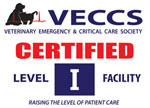Date:
By Dr. Allen Green
For those of you who have undergone surgery recently, there is a high likelihood that it was performed via a technique known as minimally invasive surgery. The advantages of this technology are numerous and we offer it at our Center for Orthopedic and Minimally Invasive Surgery.
We are pleased to inform you that our guest veterinarian contributor this month is one of our surgeons, Dr. David Dycus. Along with routine soft tissue and orthopedic surgeries, both of our surgeons, Dr. Dycus and Dr. Au, are highly skilled in the use of minimally invasive techniques.
The use of so-called minimally invasive surgery or MIS has gained wide use in human medicine for a number of conditions. But, did you know that we can use the same technology in veterinary medicine? To start MIS involves the use of small incisions where a tiny camera is inserted and then other small instruments are used for a variety of reasons. This does away with large incisions and has been reported to speed up healing time and reduce pain. So what does this mean for you furry friend? A quicker return to function and less pain so that he or she can be back to doing the fun things in life! Lets look at a few different areas where MIS can be used.
In our canine athletes joint injuries are common and sometimes the diagnosis is not very clear. The use of arthroscopy, or putting a small camera into a joint, allows us to look at the structures that make up the joint, diagnose the problem, and sometimes, even correct the problem. The best benefit is that arthroscopy can be done as an outpatient basis and allow us to see the inside of the joint under magnification and great lighting. The surgeons at CVRC are able to use arthroscopy to look into shoulders, elbows, and knees. After this procedure, recovery time can vary from two to six weeks, depending on what was done. In addition to joints, fractures can now be repaired using minimally invasive techniques and fluoroscopy (moving x rays) without creating the large incisions that would ordinarily be needed to repair them. Again, less pain, faster healing and quicker return to function are the advantages.
Another use of MIS is what is called laparoscopy. A small camera is inserted into the belly where we can look around at all the organs to help us make a diagnosis and treat problems. Probably the best use of laparoscopy is for the use of liver biopsies. This can benefit our canine and feline friends that suffer from elevations in liver values that may not respond to the typical treatment. At CVRC’s Center for Orthopedic and Minimally Invasive Surgery, we offer this service to help your veterinarian get a full diagnosis so that he or she knows how to better help your pet. When using a scope, there are two to three tiny incisions, allowing most animals get back to normal activity within a day or two. The incisions take about two weeks to fully heal and this approach avoids the long incision along the belly traditionally needed for this procedure.
Laparoscopy has many other uses such as allowing us to get biopsies of the intestine, remove small masses from various organs, and helps up perform a procedure called a gastropexy. For those of you that have large or giant breed dogs such as a Great Dane, a gastropexy is very important in preventing what’s called gastric dilatation and volvulus (GDV) or what its better know as: bloat. If any of you have seen the movie “Marley and Me” this is the disease that affected Marley. Our large breed friends are at a very heightened risk for this to happen and when it does it’s an emergency. However, it can be prevented by electing to have a gastropexy performed, which will reduce the risk to less than 10 percent. The procedure involves one small incision on the belly to insert the scope and another incision just behind the rib. The stomach is pulled over and attached to the body wall, which will keep it from rotating. This is another procedure that the surgeons at CVRC will be happy to do or discuss with you if you feel your furry friend might benefit from it.
One last use of MIS is what is called thoracoscopy where a miniature camera is inserted into the chest and we are able to view the lungs, heart and other vital structures. Once again, this will allow us to help diagnose and even treat conditions without having to make a big incision on the chest, which can be quite painful.
Minimally invasive surgery has many uses that can benefit your pet. If your veterinarian has recommended surgery for certain causes or you feel like your friend may benefit from the use of MIS, please request a referral to our Center for Orthopedic and Minimally Invasive Surgery so we can evaluate your pet and discuss if MIS is right for you.







